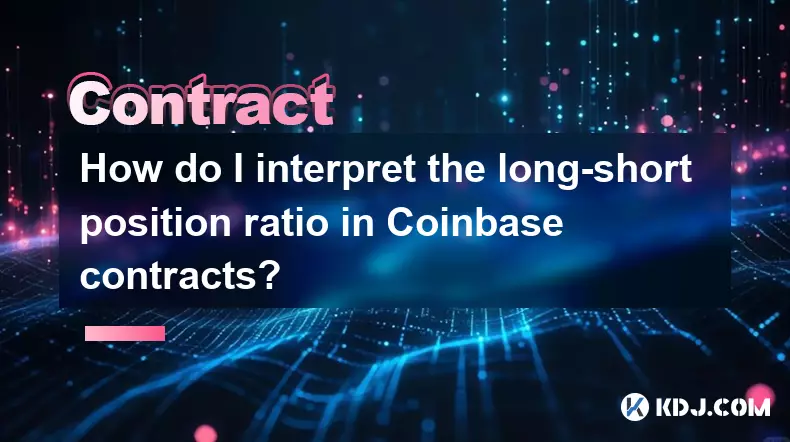-
 bitcoin
bitcoin $109667.069529 USD
-3.03% -
 ethereum
ethereum $3936.685804 USD
-4.07% -
 tether
tether $1.000493 USD
0.01% -
 xrp
xrp $2.771823 USD
-4.74% -
 bnb
bnb $957.805027 USD
-5.34% -
 solana
solana $196.735100 USD
-6.68% -
 usd-coin
usd-coin $0.999727 USD
-0.01% -
 dogecoin
dogecoin $0.227355 USD
-5.12% -
 tron
tron $0.335205 USD
-0.81% -
 cardano
cardano $0.779256 USD
-3.59% -
 ethena-usde
ethena-usde $0.999900 USD
-0.06% -
 hyperliquid
hyperliquid $42.492095 USD
-6.61% -
 chainlink
chainlink $20.501853 USD
-4.34% -
 avalanche
avalanche $28.952606 USD
-11.21% -
 stellar
stellar $0.356038 USD
-3.93%
How do I interpret the long-short position ratio in Coinbase contracts?
The long-short ratio on Coinbase reflects market sentiment by comparing long and short positions, with values above 1.0 signaling bullishness and below 1.0 indicating bearishness, but extreme levels may warn of impending reversals due to overleveraging.
Sep 20, 2025 at 08:55 pm

Understanding the Long-Short Position Ratio in Coinbase Contracts
The long-short position ratio is a key metric used by traders to gauge market sentiment on Coinbase and other cryptocurrency derivatives platforms. This ratio reflects the proportion of open long positions (bets that prices will rise) to short positions (bets that prices will fall). A balanced ratio typically hovers around 1.0, indicating equal bullish and bearish interest. Deviations from this equilibrium can signal shifts in trader behavior.
When analyzing this data, it's essential to consider both the direction and magnitude of the ratio. A value above 1.0 suggests more traders are holding long positions, potentially indicating optimism. Conversely, a ratio below 1.0 implies greater short-side exposure, often interpreted as bearish sentiment. However, extreme values may also point to overleveraged conditions that could precede reversals.
What Does a High Long-Short Ratio Indicate?
- A high long-short ratio, such as 1.5 or higher, shows that significantly more capital is committed to long positions.
- This condition often emerges during strong upward price momentum when traders chase gains.
- Elevated long dominance increases the risk of a short-term correction due to potential long liquidations.
- Market makers and algorithms may detect this imbalance and adjust pricing models accordingly.
- Historical patterns show that prolonged periods of high long ratios sometimes precede sharp pullbacks.
How Traders Use the Ratio for Tactical Decisions
- Scalpers monitor real-time changes in the ratio to identify sudden bursts of buying or selling pressure.
- Swing traders compare current levels against historical averages to assess whether the market is overextended.
- Some strategies involve fading extremes—taking contrarian positions when the ratio reaches multi-week highs or lows.
- Institutional participants integrate the ratio with order book depth and funding rates for confirmation.
- Automated trading bots use threshold-based triggers from the ratio to enter or exit positions.
Limitations and Risks of Relying Solely on the Ratio
- The ratio does not distinguish between retail and institutional positions, which can skew interpretation.
- Large whale accounts can distort the overall figure even if their activity represents a small number of trades.
- It fails to account for position size distribution; a few massive shorts can outweigh thousands of small longs.
- On Coinbase specifically, limited contract offerings compared to larger exchanges reduce data depth.
- Sudden news events can invalidate existing ratios before traders have time to react.
Frequently Asked Questions
Can the long-short ratio predict price movements accurately?While the ratio provides insight into market psychology, it is not a standalone predictor. Price action, volume, and macroeconomic factors must be analyzed alongside it to improve accuracy.
Where can I find the long-short ratio for Coinbase futures?Coinbase does not publish this data directly. Third-party analytics platforms aggregate open interest from available feeds and calculate the ratio using accessible API data.
Does a low ratio always mean a price drop is imminent?No. A low ratio indicates bearish positioning but does not guarantee further downside. Markets can remain oversold for extended periods, and unexpected catalysts may trigger short squeezes.
How frequently is the long-short ratio updated on tracking sites?Most services update the ratio every 5 to 15 minutes based on exchange-reported snapshots of open interest, though delays can occur during peak volatility.
Disclaimer:info@kdj.com
The information provided is not trading advice. kdj.com does not assume any responsibility for any investments made based on the information provided in this article. Cryptocurrencies are highly volatile and it is highly recommended that you invest with caution after thorough research!
If you believe that the content used on this website infringes your copyright, please contact us immediately (info@kdj.com) and we will delete it promptly.
- Bitwise, Hyperliquid ETF, and Perp DEXs: A New Era in Crypto Trading?
- 2025-09-26 12:25:15
- Ozak AI Price Prediction: Analyst Bull Case for $5 by 2026?
- 2025-09-26 12:25:15
- Bitcoin Price Wobbles: Support Failure and Trader Sentiment in the Mix
- 2025-09-26 12:45:16
- Dogecoin, Memecoins, and the Bull Cycle: Are We Still Barking Up the Right Tree?
- 2025-09-26 12:45:16
- Crypto Tax, Senate Showdown, and Trump Relief: What's the Deal?
- 2025-09-26 12:30:01
- Big Rocking Horse, Coin, and Ice Cream: An Aussie Icon's Sweet Ride
- 2025-09-26 10:45:16
Related knowledge

How do I enable the "scalping-only" mode for Cardano (ADA) contracts?
Sep 24,2025 at 03:19am
Understanding Scalping Strategies in Crypto Derivatives1. Scalping in cryptocurrency trading refers to executing multiple short-term trades within min...

What is the maximum position limit for Cardano (ADA) contracts?
Sep 23,2025 at 11:00pm
Understanding ADA Futures and Derivatives Market Structure1. Cardano (ADA) futures contracts are offered by several major cryptocurrency derivatives e...

What is the maker fee for Cardano (ADA) contracts?
Sep 26,2025 at 09:01am
Understanding Maker Fees in Cardano (ADA) Contracts1. The concept of maker fees applies broadly across decentralized exchanges and smart contract plat...

How can I view open interest in Cardano (ADA) contracts?
Sep 24,2025 at 07:36am
Understanding Open Interest in Cardano Derivatives1. Open interest refers to the total number of outstanding derivative contracts, such as futures or ...

What is the function of the insurance fund in Cardano (ADA) contracts?
Sep 24,2025 at 02:18am
Understanding the Role of Insurance Funds in Cardano Smart Contracts1. The insurance fund within Cardano's ecosystem is not a native feature directly ...

How can I view historical transaction records for Cardano (ADA) contracts?
Sep 24,2025 at 04:01pm
Understanding Cardano's On-Chain Data Structure1. Cardano operates on a proof-of-stake blockchain that records all transactions in blocks secured thro...

How do I enable the "scalping-only" mode for Cardano (ADA) contracts?
Sep 24,2025 at 03:19am
Understanding Scalping Strategies in Crypto Derivatives1. Scalping in cryptocurrency trading refers to executing multiple short-term trades within min...

What is the maximum position limit for Cardano (ADA) contracts?
Sep 23,2025 at 11:00pm
Understanding ADA Futures and Derivatives Market Structure1. Cardano (ADA) futures contracts are offered by several major cryptocurrency derivatives e...

What is the maker fee for Cardano (ADA) contracts?
Sep 26,2025 at 09:01am
Understanding Maker Fees in Cardano (ADA) Contracts1. The concept of maker fees applies broadly across decentralized exchanges and smart contract plat...

How can I view open interest in Cardano (ADA) contracts?
Sep 24,2025 at 07:36am
Understanding Open Interest in Cardano Derivatives1. Open interest refers to the total number of outstanding derivative contracts, such as futures or ...

What is the function of the insurance fund in Cardano (ADA) contracts?
Sep 24,2025 at 02:18am
Understanding the Role of Insurance Funds in Cardano Smart Contracts1. The insurance fund within Cardano's ecosystem is not a native feature directly ...

How can I view historical transaction records for Cardano (ADA) contracts?
Sep 24,2025 at 04:01pm
Understanding Cardano's On-Chain Data Structure1. Cardano operates on a proof-of-stake blockchain that records all transactions in blocks secured thro...
See all articles










































































